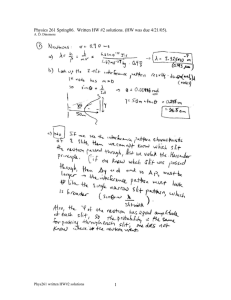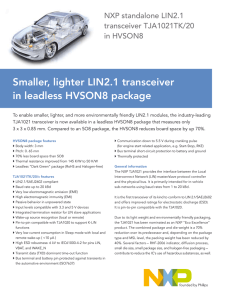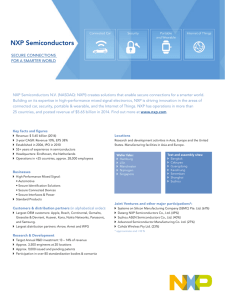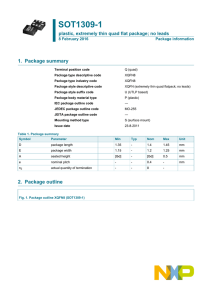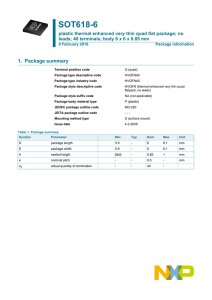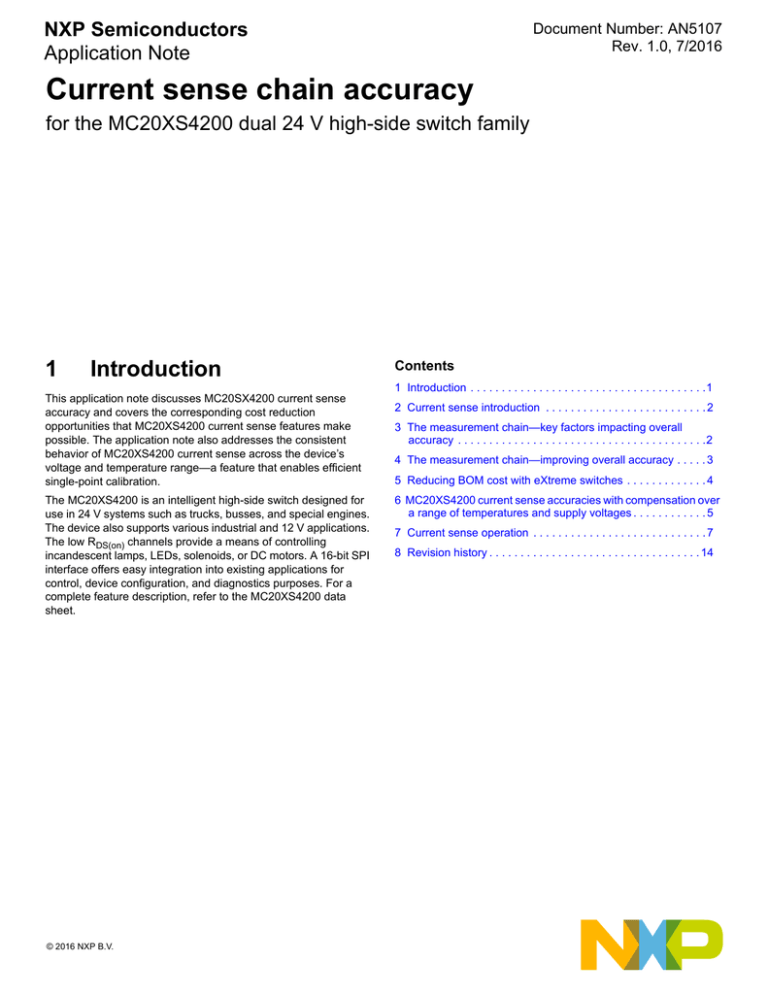
NXP Semiconductors
Application Note
Document Number: AN5107
Rev. 1.0, 7/2016
Current sense chain accuracy
for the MC20XS4200 dual 24 V high-side switch family
1
Introduction
This application note discusses MC20SX4200 current sense
accuracy and covers the corresponding cost reduction
opportunities that MC20XS4200 current sense features make
possible. The application note also addresses the consistent
behavior of MC20XS4200 current sense across the device’s
voltage and temperature range—a feature that enables efficient
single-point calibration.
The MC20XS4200 is an intelligent high-side switch designed for
use in 24 V systems such as trucks, busses, and special engines.
The device also supports various industrial and 12 V applications.
The low RDS(on) channels provide a means of controlling
incandescent lamps, LEDs, solenoids, or DC motors. A 16-bit SPI
interface offers easy integration into existing applications for
control, device configuration, and diagnostics purposes. For a
complete feature description, refer to the MC20XS4200 data
sheet.
© 2016 NXP B.V.
Contents
1 Introduction . . . . . . . . . . . . . . . . . . . . . . . . . . . . . . . . . . . . . .1
2 Current sense introduction . . . . . . . . . . . . . . . . . . . . . . . . . . 2
3 The measurement chain—key factors impacting overall
accuracy . . . . . . . . . . . . . . . . . . . . . . . . . . . . . . . . . . . . . . . .2
4 The measurement chain—improving overall accuracy . . . . . 3
5 Reducing BOM cost with eXtreme switches . . . . . . . . . . . . . 4
6 MC20XS4200 current sense accuracies with compensation over
a range of temperatures and supply voltages . . . . . . . . . . . . 5
7 Current sense operation . . . . . . . . . . . . . . . . . . . . . . . . . . . . 7
8 Revision history . . . . . . . . . . . . . . . . . . . . . . . . . . . . . . . . . . 14
Current sense introduction
2
Current sense introduction
The MC20XS4200 eXtreme power switch for 24 V applications provides two current sense ratios that support a range of low-current to
high-current applications. The MC20XS4200 current sense is highly accurate by design. In addition, the device also offers features that
allow you to enhance current sense accuracy and reduce cost across the current measurement chain.
The following sections review the MC20XS4200 current sense features and discuss the cost reduction and integration opportunities they
present.
3
The measurement chain—key factors impacting overall
accuracy
Each element in the measurement chain has its own level of accuracy. The accuracy of each of these elements impacts the overall
accuracy of the chain. The worst-case accuracy for the measurement chain is the sum of each individual element’s worst-case accuracy.
Figure 1 shows a typical measurement chain for a given range of load currents. Notice that the drawing illustrates a basic measurement
chain. In practice, some chains may include operational amplifiers and filters, depending on the application.
Figure 1. Measurement chain
Current sense chain accuracy, Rev. 1.0
NXP Semiconductors
2
The measurement chain—improving overall accuracy
4
The measurement chain—improving overall accuracy
Random offset refers to an inherent variability in the semiconductor fabrication process that causes key parameters to differ slightly from
part to part. Random offset variations are sporadic by nature but can be influenced by supply voltage and device temperature. NXP’s
eXtreme switches provide a feature that compensates for the affects of random offset.
When activated, the compensation feature factors in random offsets in temperature and voltage, thereby yielding greater accuracy across
the measurement chain.
Figure 2. Addressing current sense accuracy
Current sense chain accuracy, Rev. 1.0
NXP Semiconductors
3
Reducing BOM cost with eXtreme switches
5
Reducing BOM cost with eXtreme switches
Figure 3 shows the external sense accuracy of a regular power switch with no compensation or calibration applied. The sense must be as
accurate as possible to eliminate any impact on the current measurement chain.
Figure 3. External sense accuracy with no compensation or calibration
Figure 4 shows the external sense accuracy of an MC20XS4200 device (20 mΩ.) The maximum accuracy is ±5.5% using the
compensation feature. (Calibration was not performed, in this example.)
For applications requiring ±8% for the measurement chain, use higher valued resistors (<1%.)
Figure 4. External sense accuracy with MC20XS4200
Current sense chain accuracy, Rev. 1.0
NXP Semiconductors
4
MC20XS4200 current sense accuracies with compensation over a range of temperatures and supply voltages
6
6.1
MC20XS4200 current sense accuracies with compensation
over a range of temperatures and supply voltages
MC20XS4200 current sense accuracy +125 °C
Figure 5 and Figure 6 show the current sense accuracy of an MC20XS4200 with the compensation feature activated, but with no
calibration applied. At 125 °C, accuracy remains at ±5.5% across the supply voltage range. Below 0.75 A, change the current sense mode
from high current mode (CSNS=0) to low current mode (CSNS=1) to assure that accuracy remains in the ±5.5% range.
In Figure 5, the bar graph to the right of the chart illustrates the expected distribution for accuracy within the defined limits
(Average = ±3 σ.) This distribution applies under all conditions (voltage or temperature and current sense ratio.)
Figure 5. MC20XS4200 current sense accuracy—125 °C / 36 V
Figure 6. MC20XS4200 current sense accuracy—125 °C / 8 V
Current sense chain accuracy, Rev. 1.0
NXP Semiconductors
5
MC20XS4200 current sense accuracies with compensation over a range of temperatures and supply voltages
6.2
MC20XS4200 current sense accuracy -40 °C
At -40 °C, current sense accuracy remains within ±5.5% across the supply voltage range. Below 0.75 A, change the current
sense mode from high current mode (CSNS=0) to low current mode (CSNS=1) to assure that accuracy remains in the ±5.5% range.
Figure 7 and Figure 8 illustrate the current sense accuracy at -40 °C.
Figure 7. MC20XS4200 current sense accuracy at –40 °C / 36 V
Figure 8. MC20XS4200 current sense accuracy at –40 °C / 8 V
Current sense chain accuracy, Rev. 1.0
NXP Semiconductors
6
Current sense operation
7
Current sense operation
The MC20SX4200 has two load current sensing modes: synchronous mode and track & hold mode.
In synchronous mode, the load current is duplicated at the current sense pin and is therefore synchronous with it. However,
after Turn-OFF, the current sense pin does not retain the load current value. In track & hold mode, the current sense pin
retains the load current value present at Turn-OFF.
Synchronous mode is activated by setting the T_H_en bit to 0; Track & Hold mode is activated by setting the T_H_en bit to 1
To synchronize current sensing with an external process, connect the SYNC signal to the digital input of an external MCU.
SYNC is asserted logic low when the current sense signal is accurate and ready to be read.
Note: Refer to the MC20XS4200 data sheet for timing information.
Figure 9. Current sense connections
Figure 10. Synchronous and track-and-hold current sensing modes: associated delay and settling times
Current sense chain accuracy, Rev. 1.0
NXP Semiconductors
7
Current sense operation
7.1
Current sense definition and errors
7.1.1
Current sense ratio selection
The CSNS_ratio bit in the OCR register selects the sense ratio of the load current at the CSNS pin. For optimal accuracy at
low current levels, select the lower current sensing ratio (CSR1).
7.1.2
Current sensing errors
ICSNS = (IHSx + ILOAD_ERR_SYS + ILOAD_ERR_RAND) x CSRX
where:
IHSx
=
current in the load
ILOAD_ERR_SYS
=
systematic error due to process, voltage and temperature (value available in the datasheet)
ILOAD_ERR_RAND
=
random offset error, randomly distributed with an average of zero. This error can be
identified with the compensation technique. (See Section 7.1.3 "Current activation and use
of offset compensation")
CSRO = 1/1500 + εGAIN0
CSR1 = 1/500 + εGAIN1
where:
εGAIN0 + εGAIN1
=
Gain errors. Can be reduced by a calibration point in the range of interest
CSR0
=
High current ratio
CSR1
=
Low current ratio
1/1500
=
High current ratio CSR0 for MC20XS4200
1/500
=
Low current ratio CSR1 for MC20XS4200
7.1.3
Current activation and use of offset compensation
An embedded feature in the MC20XS4200 provides a means of generating the opposite value of the random offset. Enabling
the bit OFP_s in the RETRY register causes the MC20XS4200 to generate an opposite value on the next current
measurement.
Two measurements are needed: ICSNS1 (initial current value) and ICSNS2 (current value with opposite random offset.) (See
Figure 11).
ICSNS1 = (IHSx + ILOAD_ERR_SYS + ILOAD_ERR_RAND) x CSRx
ICSNS2 = (IHSx + ILOAD_ERR_SYS - ILOAD_ERR_RAND) x CSRx
ILOAD_ERR_RAND = (ICSNS1 - ICSNS2) / (2 x CSRx)
Therefore:
ICSNS_COMPENSATED = (ICSNS1 + ICSNS2) / 2
IHS[0:1] = (ICSNS_COMPENSATED / CSRx) - ILOAD_ERR_SYS
Current sense chain accuracy, Rev. 1.0
NXP Semiconductors
8
Current sense operation
Figure 11. Sequence for current measurement for compensation
The MC20XS4200’s random offset feature provides a means of achieving a high level of accuracy, especially under low
current conditions. A major advantage of this feature is that the computation can be easily embedded in software, because
ILOAD_ERR_SYS is the same for all devices.
NOTE
For any computation of the compensated current, the OFP bit must be toggled between the
two measurements.
7.1.4
Offset compensation using software
Figure 12 illustrates the sequence of steps required to implement the MC20SX4200’s compensation feature in software.
Current sense chain accuracy, Rev. 1.0
NXP Semiconductors
9
Current sense operation
Set bit D5 of the OCR register to select CSR1
ratio for the channel to be measured
Measure and record ICSNS1 with respect to
delays if the output is switched
Set bit OFP_s = 1 (D8 of RETRY register)
Measure and record ICSNS2
Compute ICSNS_compensated =
(ICSNS1 + ICSNS2) / 2
Compute load current I HS[0:1] =
ICSNS_COMPENSATED / CSRx – ILOAD_ERR_SYS
CSR1 = 1/500 for
MC20XS4200
ILOAD_ERR_SYS = -5 mA for
MC20XS4200
Figure 12. Software sequence for compensation current measurement
7.1.5
Current sense calibration
A calibration can be performed to improve measurement chain accuracy. To do so, you must record—during end of line
testing—the difference between the theoretical measurement chain accuracy and the actual measured value. Then use the
extracted delta current to adjust all future measurements.
Current sense chain accuracy, Rev. 1.0
NXP Semiconductors
10
Current sense operation
Figure 13. Current calibration
This calibration incorporates the sense ratio and the internal conversion stage, thereby addressing the gain error (εGAIN0).
The calibration can be done at ambient temperature using the application’s targeted supply voltage.
With eXtreme switch, all devices behave consistently across their temperature and supply voltage range. Each device may
exhibit its own unique performance characteristics within the normal distribution for similar devices. However, those
individual characteristics remain stable at different temperatures and voltages because the MC20SX4200’s compensation
feature minimizes the affect of temperature and voltage variations. Therefore, the calibration can be performed at room
temperature using a single voltage (see Figure 14 for an MC20XS4200 in the 300 mA-3 A range.)
Figure 14. Consistency of current measurement across voltage and temperature
Current sense chain accuracy, Rev. 1.0
NXP Semiconductors
11
Current sense operation
7.1.6
Compensation and calibration example with high current mode
Figure 15 illustrates how to proceed with both compensation and calibration. In the example, the current sense mode is
CSR0 (high current e.g CSNS_ratio_s = 0). The load is a 25 Ω resistor. ILOAD_ERR_SYS is not embedded in the
computation. The calibration will embed the systematic error. The percentage in brackets represents accuracy with respect
to the target.
Figure 15. Calibration and compensation example using high current sensing accuracy (CSR0)
Current sense chain accuracy, Rev. 1.0
NXP Semiconductors
12
Current sense operation
7.1.7
Compensation and calibration example with low current mode
Figure 16 provides another example of how to proceed with both compensation and calibration. In the example, the current
sense mode is CSR1 (e.g CSNS_ratio_s = 1) for very low current. The load is a 270 Ω resistor. ILOAD_ERR_SYS is not
embedded in the computation. The calibration will embed the systematic error. The percentage in brackets represents
accuracy with respect to the target.
For a single point of calibration, worst case accuracy remains within 2% for current (35 times lower than nominal current.)
Figure 16. Calibration and compensation example using low current sensing accuracy (CSR1)
Current sense chain accuracy, Rev. 1.0
NXP Semiconductors
13
Revision history
8
Revision history
Revision
1.0
Date
Description
6/2015
• Initial release
7/2016
• Updated to NXP document form and style
Current sense chain accuracy, Rev. 1.0
NXP Semiconductors
14
How to Reach Us:
Information in this document is provided solely to enable system and software implementers to use NXP products. There
Home Page:
NXP.com
are no expressed or implied copyright licenses granted hereunder to design or fabricate any integrated circuits based on
Web Support:
http://www.nxp.com/support
NXP makes no warranty, representation, or guarantee regarding the suitability of its products for any particular purpose,
the information in this document. NXP reserves the right to make changes without further notice to any products herein.
nor does NXP assume any liability arising out of the application or use of any product or circuit, and specifically disclaims
any and all liability, including without limitation, consequential or incidental damages. "Typical" parameters that may be
provided in NXP data sheets and/or specifications can and do vary in different applications, and actual performance may
vary over time. All operating parameters, including "typicals," must be validated for each customer application by the
customer's technical experts. NXP does not convey any license under its patent rights nor the rights of others. NXP sells
products pursuant to standard terms and conditions of sale, which can be found at the following address:
http://www.nxp.com/terms-of-use.html.
NXP, the NXP logo, Freescale, the Freescale logo, and SMARTMOS are trademarks of NXP B.V. All other product or
service names are the property of their respective owners. All rights reserved.
© 2016 NXP B.V.
Document Number: AN5107
Rev. 1.0
7/2016

